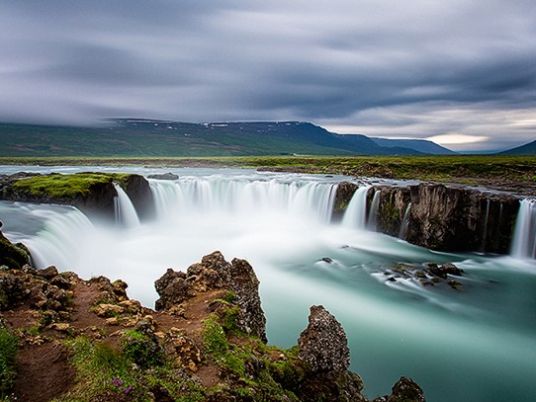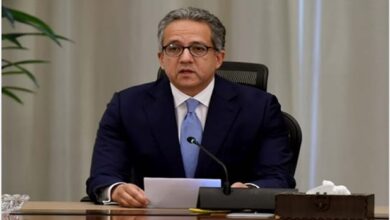Of the 936 World Heritage sites around the globe, 69 are found in the 18 Arab countries that have adhered to the World Heritage Convention, but only four of those locations deemed worthy of protection are natural sites.
The United Nations Educational, Scientific and Cultural Organization (UNESCO) committee in charge of inducting new natural, cultural and mixed property sites to the list held its 35th annual session in Paris in June, during which it doled out the World Heritage logo to 25 new sites – 21 cultural, three natural and one mixed property.
A tour of UNESCO's interactive map of the world’s cultural and natural sites provides a visual of how few of the region's natural sites are included.
The Wadi Rum protected area in Jordan joined the list this year as a mixed property site, which is a site that has both cultural and natural value. The 74,000-hectacre property near the border of Saudi Arabia features a varied desert landscape and illustrates the evolution of pastoral, agricultural and urban activity in the region.
Mauritania’s sole natural site – Banc d’Arguin National Park – on the Atlantic Coast was listed in 1989. It offers an extraordinary contrast between the harshness of the desert landscape and the rich biodiversity of its seascape.
Ichkeul National Park in Tunisia, inscribed in 1980, features the last remaining lake in a chain that once extended across Africa and is still a major stop for migrating birds.
In 2008, the Socotra Archipelago was recognized as a natural site by the World Heritage Committee. Located in the northwest Indian Ocean near the Gulf of Aden, the 250-km-long archipelago comprised of four islands is of universal importance because of its biodiversity.
Egypt, the fourth state with a recognized natural site, has had its Wadi al-Hitan, or Valley of the Whales, on the list since 2005. The valley contains invaluable fossil remnants of the earliest sub-order of whales, the Archaeoceti, which represent one of the major stories of evolution: the transition of the whale from land to marine mammal.
The International Union for Conservation of Nature (IUCN), the world’s oldest and largest global environmental organization, which also advises UNESCO on natural sites, recently issued a report tackling the lack of natural World Heritage Sites in the region.
Entitled “Tabe’a: Nature and World Heritage in the Arab States: towards future IUCN priorities,” the report tries to determine the reasons why the number of enlisted natural sites is so little in the region in spite of its wealth in dramatic desert landscapes and rich sea bed. It also recognizes the need to strengthen the identification, conservation and presentation of the region’s natural heritage and provides a comprehensive overview of the actual situation.
For the past 15 years, the IUCN has advised Arab countries to try to get more sites on the tentative list, but in its new report, the organization said this has not translated as an effective first step to getting the sites World Heritage status.
Haifaa Abdulhalim, the IUCN World Heritage officer in the Arab states who contributed to the report, said tentative lists are effective tools for the inventory of sites with a potential outstanding universal value (OUV). “But in the case of the Arab states, there has been an insufficient analysis of the OUV of the sites arising from both a lack of consideration of World Heritage criteria and from inadequate management and site protection requirements,” she said.
Also, they tend to ignore the three pillars that support the OUV concept: conditions of integrity of the site, adequate management and protection, she said.
Arab states tend not to update or revise their tentative lists, and often fail to properly enhance a proposed site’s value, she said.
Gihane Zaki, Egypt’s point person for the World Heritage Commission and adviser to the Minister of Antiquities for the International Organizations, has a slightly different interpretation.
“Since 2000 approximately, building nomination files for either cultural or natural sites has become much more tedious: the level of restriction has gone up, surveillance as well, and the follow-up has become very rigorous,” she said.
According to Zaki, many photographs and documents are required just to put a site on UNESCO's tentative list.
UNESCO’s biggest fear is that the World Heritage list will become one of tourist destinations, she said, and this is why they have made the process more difficult for both cultural and natural sites.
“In five years, the World Heritage Committee will celebrate its 40th anniversary and 1000 sites are expected to be integrated on its official World Heritage List,” Zaki said.
Also, any site that is selected to be inscribed on the tentative list needs to be registered under the state’s heritage, “but in Egypt there is no such list giving an inventory for either cultural or natural sites, because we have not decided yet which authority should run this heritage list, which slows down the process,” she stresses.
Abdulhalim said the weak representation of Arab sites on the list is a sign of poor coordination among national institutions responsible for the implementation of the World Heritage Convention.
“These institutions are more focused on cultural heritage, which explains the weak involvement or even absence of institutions concerned with the protection of nature," Abdulhalim said.
Although there has been some recent progress concerning the implementation of the World Heritage criteria, there is still room for improvement and enhancement in implementing the convention, Abdulhalim said.
“IUCN is looking forward to work on capacity-building programs in partnership with the UNESCO World Heritage Center, and to support the creation and development of regional centers with expertise on Nature Conservation and World Heritage,” she said.
She reaffirms IUCN's support for the proposed Arab Regional Center for World Heritage in Bahrain, which carries out the UNESCO World Heritage Center mission on a local level and offers support for Arab countries applying to put a country on the World Heritage list. This center is also expected to provide training, consultancy and support for the maintenance and renovation of sites and spread awareness on the importance of cultural and natural heritage in the region.
Abdulhalim said that although supporting this center is a priority for the organization's World Heritage Program, “the lack of funding and financial resources is the major obstacle for its implementation.
Zaki agrees that a wide educational campaign of sensitization of national’s cultural and natural heritage needs to be launched on a wide scale in Egypt and address young kids, teenagers and mothers.
Arab states have a wealth of natural sites, from the region's deserts to rich marine resources, many of which are trans-boundary. Could the fact that neighboring countries would have to engage in talks and agree on how to present a natural site that crosses their borders contribute to the region's lack of protected sites?
Abdulhalim explains that across the world – not just in Arab states – border areas tend to coincide with areas of high conservation interest because these often inhospitable, rugged and water-deprived areas were vaguely defined due to lack of interest in the buffer zones.
“Border disputes are becoming more common over access to resources, and this is not helping trans-boundary agreements, but the good news is that conservation areas can also build bridges of communication between countries,” Abdulhalim said.
There is a strong synergy between the cultural or natural and politics, Zaki said, and without a green light from the government, a site cannot become part of the tentative list.
“In 2003, the site of Dahab was supposed to be put up on the tentative list as a natural site, but of course there was a strong political will against putting the area under UNESCO [oversight] for obvious security reasons,” she said, adding that when a site is stamped “World Heritage,” the government has to get permission from UNESCO for new developments.



